Margaret Tafoya Pottery, Santa Clara, Carved, signed, black Serpent 1950's-1960's
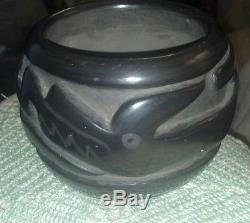

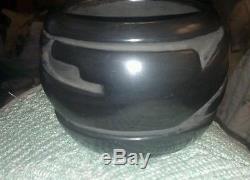
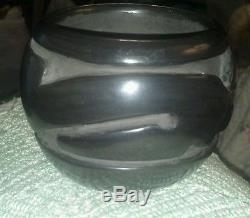
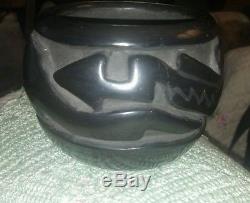
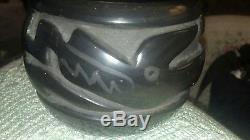
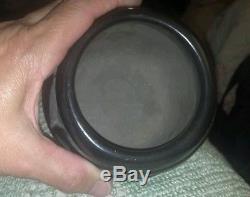
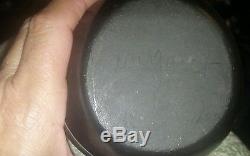


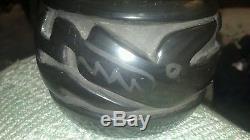

Margaret Tafoya Santa Clara Pueblo Black on Black Carved Water Serpent Bowl. This piece is in beautiful condition. It would be a stunning addition to ANY Native American pottery collection.
The dimensions of this pot are approximately 3" tall and 4" diameter. It measures 13-1/4 around the widest part of the bowl. It is signed by Margaret Tafoya (signed "Margaret")on the bottom of the pot.If you have any questions about this pot, please ask. Santa Clara Black on Black carved pueblo design bowl.
Dimensions: 4"wide x 3" tall. Overall this is a very nice example of her work. Maria Margarita "Margaret" Tafoya Tewa name. Corn Blossom ; August 13, 1904 February 25, 2001 was the matriarch of Santa Clara Pueblo. Margaret learned the art of making pottery. From her parents Sara Fina Guiterrez Tafoya (18631949) and Jose Geronimo Tafoya (18631955). Sara Fina was considered the leading potter of Santa Clara in her day, as the master of making exceptionally large, finely polished blackware. She also occasionally made redware, micaceous. Clay storage jars and other smaller utilitarian forms. Margarets father was primarily concerned with raising food for the family but he was also known to make pottery and helped Sara Fina with many aspects of her pottery production. In 1924, Margaret married her husband Alcario Tafoya (19001995). Alcario and Margaret worked together making pottery just as her mother and father had done.Margaret and Sara Finas husbands both helped with the tasks of digging and preparing the clay and the firing of the pots. Alcario also helped Margaret with the creation and carving of designs on her pots. Like her mother, Margaret molded her pots using the traditional coiling method.
"This method and many of the techniques used in the production of her pottery has been dated as being as more than 1200 years old, with the ancient "Anasazi of the Colorado Plateau being the founding culture. A common misconception was the belief that black on black, burnished pueblo pottery had "died out, " according to Larry Frank and Francis H. "In reality, the nearby inhabitants of Santa Clara Pueblo were still producing the highly burnished, black on black pottery, since the 1600s, therefore lending to the revival of the San Ildefonso style of black on black "painted pottery. The only difference between the two pueblo's styles is that in Santa Clara, pots are deeply carved and incised, whereas, in San Ildefonso, the pottery is generally not carved and painted with pigments to cause un-polished designs on a polished surface. In the early 1900s, as Maria Martinez.Was developing the San Ildefonso style of traditional pottery, it was well known that she in fact learned various polishing (burnishing) techniques from Margaret Tafoya, as well as how to turn any color of clay black, by simply smothering the fire with manure. Margaret continued her mothers tradition of making exceptionally large pots, with finely polished surfaces and simple carved designs. Her bear paw motif and deeply carved pueblo. Steps around the shoulder of her jars have become signature trademarks of the Tafoya family pottery. By the 1960s Margarets pottery had become famous.
She received the Best of Show Award in 1978 and 1979 at the Santa Fe Indian Market. In 1984, the National Endowment for the Arts.Awarded her a National Heritage Fellowship. In recognition of her accomplishments. She was also recognized and received an award as a Master Traditional Artist in 1985.
In 1992 she received the Lifetime Achievement Award from the national Women's Caucus for Art. Over the next week I will be listing other pots from my collection, so please check my other listings. I will be downsizing and relocating from Florida to Washington state. I have enjoyed my Native pot collection for many years and it has come time for someone else to enjoy them.The item "Margaret Tafoya Pottery, Santa Clara, Carved, signed, black Serpent 1950's-1960's" is in sale since Friday, July 29, 2016. This item is in the category "Collectibles\Cultures & Ethnicities\Native American\ US\1935-Now\Pottery". The seller is "alaskapitstop" and is located in Mary Esther, Florida.
This item can be shipped to United States, BR, RU, to Canada, to United Kingdom, DK, RO, SK, BG, CZ, FI, HU, LV, LT, MT, EE, to Australia, GR, PT, CY, SI, to Japan, to China, SE, KR, ID, TH, to Belgium, to France, to Hong Kong, to Ireland, to Netherlands, PL, to Spain, to Italy, to Germany, to Austria, IL, to Mexico, to New Zealand, SG, NO, SA, UA, AE, QA, KW, BH, HR, MY, CO, PA, JM.
- Artisan: Margaret Tafoya
- Origin: Santa Clara
- Tribal Affiliation: Pueblo
- Country/Region of Manufacture: United States

